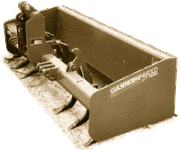</font><font color="blue" class="small">( Ozarker, I don't think you can support the statement that the arms aren't designed to push with any engineering data. Certainly the traditional draft loads have been pulling, but I'll bet you that if we sat down with the engineer who designed lift arms on any modern tractor, he would tell you that pushing in reverse was indeed taken into consideration when sizing the rear lift arms. )</font>
No need for engineering data. This is fairly basic high school geometry. The 3-point system isn't designed to push. It is designed to pull......period. In fact, everything about a tractor is designed to work in one direction. That is why they have directional tread on the tires. Implements designed to be pushed are on the front and implements designed to be pulled are in the middle or on the back.
What it is designed to do what you get away with doing are two different things. A pickup truck isn't designed to have round bails of hay hanging off the back end but people mount spikes on the ends of their trucks and do it anyway. You can tell and old used truck that use to have a hay spike mounted on it by the way the frame is bent.
Box blades are not designed to be dozers when pulling or pushing. They can make shallow cuts but the reality of the design is that they have scarfer teeth to break up the ground in front of the blade if you need to cut rather than spread material. And it is certainly not designed to be a dozier in reverse.
Just imagine for a moment if someone designed a blade for the front of the tractor that was mounted with a system as loose as a 3-point on the rear. It had to have chains or bars to limit side to side sway. People would complain about fit and finish and walk away from such a silly design.
Nope, 3-point systems are designed for pulling implements and the implements for 3-point systems are designed to be pulled. Your tires are directional and your seat faces the front. No engineering data is required.

